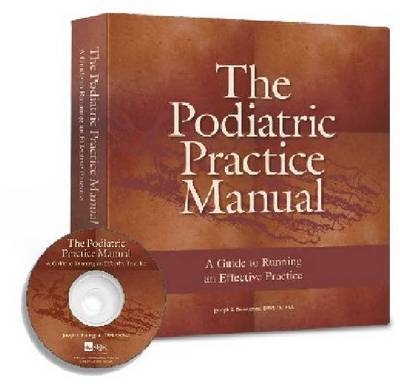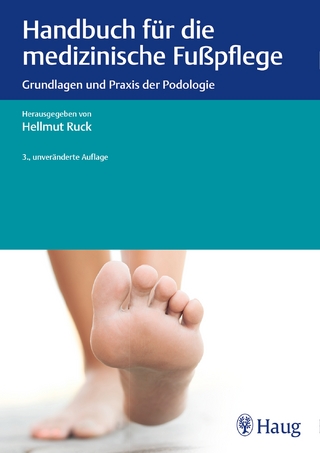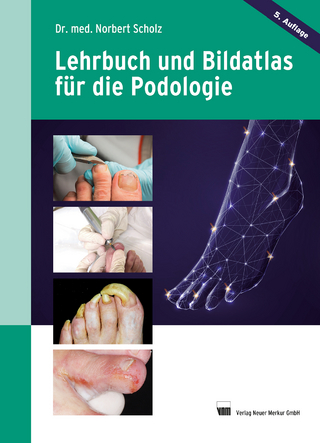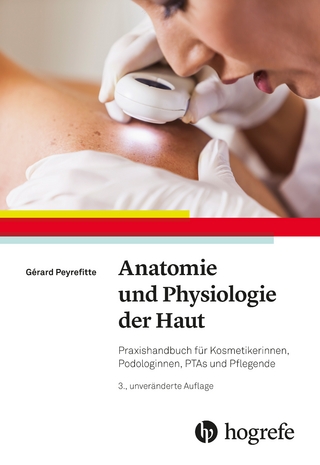
The Podiatric Practice Manual
Data Trace Publishing Company (Verlag)
978-1-57400-129-7 (ISBN)
A complete and fully customisable manual is available to the practising physician to assist with day-to-day operations. The Manual places an emphasis on improving and aiding the medical and business aspects of running an efficient and successful medical practise. An accompanying CD allows the podiatric physician and staff to customise a wide assortment of template forms, from memos for office procedures, employee job descriptions, forms for new employees to sign, and patient consent forms, to creating your own, personalised office employee handbook. This is truly a tool your office cannot do without.
Covers the following topics:
Clinical Care. The Manual's first section deals specifically with clinically related procedures such as treatment algorithms, appropriate X-ray positioning, general clinical care policies and procedures, proper documentation techniques, and caring for, ordering and dispensing medical instruments, equipment and supplies. The section concludes with a collection of essential clinical care forms and patient education materials needed for everyday operations.
Patient Relations. The second section discusses how the podiatric physician's office should manage patient appointment scheduling, insurance, new patient processing, missed appointments, and patient care outside the office. The forms provided at the end of this section will help you and your staff communicate effectively with your patients and provide staff with essential information for dealing with patient-related situations.
Office Administration.The objectives of this section include identifying the specific job responsibilities for each of the office personnel, identifying office policies such as responding to telephone calls, delays in the waiting room, and cleanliness, as well as discussing financial polices such as budgeting, accounts payable, collection policies, coding and fee schedules, and insurance and Medicare billing. Conventional administrative forms follow this section's discussions.
Personnel Policies. The Manual's fourth section contains the office staff policy guidelines, from compensation and benefits to behavioural expectations. A well thought-out personnel policy section is essential so that your employees know what is expected from them as members of your team. Key forms such as an appropriate employee warning notice and an example of a performance review are among the forms provided in this section.
Appendices. Appendix A, Model Plans and Programmes for the OSHA Bloodborne Pathogens and Hazard Communications Standards is a public domain resource reproduced in this publication as a reference tool. The Occupational Safety and Health Administration (OSHA) requires all medical offices to have an Exposure Control Plan. This plan is designed to minimise exposure to bloodborne pathogens or other infectious material.
Dr. Joseph Borreggine, is a podiatric physician and past President of the Illinois Podiatric Medical Association (IPMA) (2009-2010) and has been practising in East Central Illinois for over two decades. With his years of knowledge and experience, Dr. Borreggine is able to diagnosis and treat any foot or ankle problem. Dr. Borreggine is well-known member not only of his profession through his extensive involvement, but also in the communities that he practices. Dr. Borreggine has written numerous foot care articles for a number of local publications, appeared as a guest on area television stations as a foot health expert, and has spoken and volunteered a number times providing foot screenings at community health care events. Dr. Borreggine is duly trained in forefoot and ankle surgery and has a sub-specialty and interest in sports medicine, diabetic foot/wound care management, and peripheral arterial disease (PAD). With his recent certification to provide testing for Peripheral Arterial Disease (PAD) for the lower extremity with specialised testing equipment known as PADnet, Dr. Borreggine is able to provide early detection of poor circulation in the legs and feet. Dr. Borreggine is a member of the Illinois and American Podiatric Medical Associations IPMA and APMA, a Diplomate ofThe American Board of Podiatric Surgery, a Fellow of The American College of Foot and Ankle Surgeons and American Society of Podiatric Surgeons, and an Affiliate Member of the PAD Coalition. He is a 10-year union member, Local #45, Office of Professional International Union (OPEIU) and also served as a member of the American Diabetes Association and American Disability Analysts Association.
Section I Clinical Care 1
A. Treatment Algorithms 2
Diabetic Foot Care Algorithm 3
Plantar Fasciitis Algorithm 4
Onychomycosis Treatment Algorithm 6
Local Anesthetic Injections Protocol 7
Phenol and Alcohol Ingrown Nail Correction Procedure 10
Fiberglass Impregnated Sock Application for Custom Molded Shoes and Rx Braces 12
Ancillary Podiatric Services Algorithm 13
Preparing Patients for Surgery 14
B. X-ray Positioning 14
Anterior Posterior (AP) View (or Dorsoplantar View) 15
Lateral Projection, Weight Bearing (Medial View) 15
Lateral Oblique Projection (Medial Oblique View) 16
Medial Oblique Projection (Lateral Oblique View) 16
Lateral Projection of the Ankle (Medial Oblique View) 16
Axial Sesamoid View 17
Anterior Posterior View of the Ankle 18
Mortise View of the Ankle 18
Axial Calcaneal View of the Heel 19
Harris-Beath View of the Heel 20
C. General Clinical Care Policies and Procedures 20
Patient Being Left Alone 20
Redressing Surgical Wounds 20
In-Office Emergency 21
Hand Sanitation 21
Exposure Control Plan 22
D. Documentation 22
Patient Medical Record 22
Documentation Basics 23
Documentation Format 23
Documentation of Lab Work 23
Documentation of Prescriptions 24
Documentation of Complimentary Foot Exams 24
Using Dictation 25
Privacy Issues/HIPAA Compliance 25
HIPAA Violations 26
Medical Record Storage 27
E. Medical Instruments, Equipment and Supplies 27
Medical Instruments 27
Sterilization Procedures 27
Cold Sterilization Procedures 28
Steam Sterilization (Autoclave) Procedures 29
Sterile Instrument Handling and Storage 29
Medical Equipment 29
Nail Grinder Care 30
Durable Medical Equipment (DME) Procedures 30
Diabetic Therapeutic Shoes and Insoles 30
Prescription Diabetic Therapeutic Shoes/Insoles 31
Non-prescription Diabetic Shoes and Insoles 32
Placing Orders for DME 32
Receiving DME 33
Scheduling Patients for DME Pickup 33
Dispensing DME 35
DME Billing 35
DME Returns 35
Supplies 35
Ordering Supplies 36
Pharmaceutical Samples 37
F. Clinical Care Forms 37
Updates 37
Established Patient Medical Record Update 39
New Patient Consultation 42
Foot Screen Evaluation Form 44
Six Month Foot Care Update for Patients with Diabetes 46
Questionnaire for Patients with Diabetes 48
Consent for Treatment-Patient with Peripheral Vascular Disease or Diabetes 50
Surgery Forms 50
Pre-operative Patient Questionnaire 51
Pre-surgery Form 52
Consent for Podiatric Surgical Procedure 55
Post-operative Management 56
Post-operative Instruction Sheet 58
Post-operative Instructions 60
In-patient Surgery 61
Outpatient Surgery 63
Outpatient Surgical Instructions 66
Patient Acknowledgement of Outpatient Foot Surgery Forms 67
DME Forms 67
Diabetic Shoe Order Form 68
Diabetic Shoe Prescription Form 69
Patient Authorization for Payment/Warranty Statement for Shoe/Inserts 71
Patient Authorization for Payment and Warranty Statement for Braces 72
Orthotic Insurance Letter of Medical Necessity 73
Return Policy for Non-prescription Shoes (Orthopedic Shoes) 74
Orthotic Disclaimer 76
Certificate of Medical Necessity - Diabetic Therapeutic Shoes 77
Certification of Medical Necessity for AFO 78
Request for Certificate of Medical Necessity (CMN) from PCP 79
Certificate of Medical Necessity Reminder 80
Disclaimers 80
“At Risk Foot Care Tissue” Injury Disclaimer 81
Cortisone Injection Disclaimer 82
Patient Education Materials 82
Bunion Surgery 83
Prescription Custom Molded AFO Break-in Schedule 84
Compression Wrap Wear Instructions 85
Worker’s Compensation 85
Worker’s Compensation Patient Information 87
Forms for Medicare Beneficiaries 87
Notice to Medicare Beneficiaries about Coverage for Foot Care and Services 88
Medicare/Medicaid Authorization - Assignment Agreement for Payments
Section II Patient Relations 89
A. Scheduling 89
Appointments 90
House Calls 90
B. Recall 90
Diabetic Shoe and Insoles Recall 91
Orthotic and Orthopedic Brace Recall 93
C. Insurance 93
Insurance Predetermination 93
Secondary Insurance 93
Guarantor Status for Minors/Patients under Guardianship 95
D. New Patient Processing 96
E. No Shows 96
New Patient No-shows 97
F. Patient Care outside the Practice 98
G. Prescription Refills 99
H. Resolving Complaints from Medicare Beneficiaries 100
I. Patient Relations Forms 100
Appointment Reminder 101
Medicare Beneficiary Complaint Log 102
Orthotic Recall Letter 103
Advance Beneficiary Notice (ABN) 104
Assignment of Benefits and Release of Medical and Plan Documents 105
Acceptance of Insurance Assignment and Financial Policies 107
Introduction Letter to Medical Practice 108
Notice of Privacy Practices 113
Authorization for Release of Information 115
Discharge Due to Missed Appointments 116
Patient Discharge Disclaimer 117
Discharge Letter Due to Other Situations
Section III Office Administration 119
A. Job Responsibilities 119
Office Manager Job Responsibilities 122
Licensed Practical Nurse/Podiatric Medical Assistant Job Responsibilities 124
Receptionist Job Responsibilities 125
Administrative Assistant Job Responsibilities 126
Accounts Manager Job Responsibilities 127
Medicare Specialist Job Responsibilities 128
Billing Specialist Job Responsibilities 129
B. Office Management Policies 129
Bulletins/Policies 129
Practice Policy Creation 130
Marketing and Public Relations 130
Special Events 132
Meetings 132
Clinical Meeting 133
Business Meeting 133
Responding to Telephone Calls 134
Placing Callers on Hold 134
Telephone Triage 135
Delays in Waiting Room 135
Office Cleanliness 136
Hand Sanitation 137
C. Financial Policies 137
Annual Budget 137
Accounts Payable (AP) 138
Durable Medical Equipment (DME) Accounts Payable 138
Storage of Accounts Payable Invoices 139
Business Taxes 139
Patient/Insurance Refund Checks 139
Accounts Receivable 139
Daily Deposits 139
Billing/Superbills 140
Explanation of Benefits (EOB) Processing 141
Patient Statements 141
Deceased Patients 141
Aging Analysis Reports 141
Medicare 142
Medicare Part B Claims Processing 143
Pre- and Post-submission Review 143
Deductibles 143
Collection Policies 144
Referral to Collection Agencies 145
Referral to Attorney 145
Financial Hardship 146
Coding and Fee Schedules 146
Public Assistance 147
Deposits 147
Deposits for Durable Medical Equipment 147
Non-covered Services 148
Insurance Information for New Patients 148
Billing Secondary Insurance 148
Cash Payments 148
Office Statistical Information 149
Coding 149
Medicare Coding 150
Year-end Activities 152
D. Administrative Forms 152
Insurance Assignment Acceptance 154
Authorization for Treatment and Release of Medical Information 156
Refundable Deposit Receipt 157
Request for Financial Hardship Status 158
Collection Letter
Section IV Personnel Policies 159
A. Employee Break Periods 159
B. Educational Seminar/Travel Expense 160
C. Compensation and Benefits 160
Work Hours 160
Timesheets and Pay Periods 161
Unsupervised Work 161
Health Insurance 162
D. Time Away from Work 162
Vacation Time 162
Sickness/Disability 163
Unpaid Leave 163
Inclement Weather Days 164
E. Employee Cross Training 164
F. Employee Memos 164
G. Hiring Practices 165
New Employees 166
H. Behavioral Expectations 166
Smoking Policy 167
Telephone Usage 167
Uniforms/Work Attire 168
Office Cleanliness 169
I. Performance Evaluation, Recognition and Discipline 169
Evaluations 169
Employee Recognition 170
Discipline 170
Warnings 171
Observations 172
J. Employee Forms 172
Absence Request 173
Employee Warning Notice 174
Employee Performance Review 175
Payroll Disclaimer 176
Employment Agreement and Morals and Ethics Clause 177
Job Training Disclaimer
Section V Appendices 181
Appendix A: Model Plans and Programs for the OSHA Bloodborne Pathogens and Hazard Communications Standards
| Erscheint lt. Verlag | 30.11.2012 |
|---|---|
| Verlagsort | Towson, MD |
| Sprache | englisch |
| Maße | 279 x 292 mm |
| Themenwelt | Medizin / Pharmazie ► Gesundheitsfachberufe ► Kosmetik / Podologie |
| ISBN-10 | 1-57400-129-9 / 1574001299 |
| ISBN-13 | 978-1-57400-129-7 / 9781574001297 |
| Zustand | Neuware |
| Haben Sie eine Frage zum Produkt? |
aus dem Bereich


